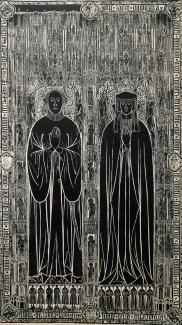
Herbert Druitt, founder of the Red House Museum, published a seminal book in two volumes, exploring the dress detail on monumental brasses around Britain, in 1906, when he was just 30 years old. This book was extraordinary, in its day, for its in-depth analysis of civilian and ecclesiastical dress. It is often quoted, not only in dictionaries on dress terminology, but also in general encyclopaedias including the now popular on-line encyclopedia, Wikipedia, where for instance the entry for the word 'chimere' for a garment worn as part of academic regalia or by Anglican bishops in choir dress, gives Druitt's book as a source of information. Druitt's book is essentially a reference book, rather like a catalogue, revealing Druitt's curatorial mind set, and clearly aimed at the historian. Taking rubbings from brasses was an established practice but the lack of detailed knowledge of the complexities of forms and layers of clothing could hamper others' efforts to date undated brasses with any degree of accuracy. Druitt presented a methodology for dating, based on sound research into historical dress.
Herbert Druitt was essentially a gentleman of leisure, trained as a lawyer but with a particular passion for collecting and documenting the past which he pursued until his death in 1943. Extant diaries record in exacting detail the minutae of his life, and his many interests. He had long collected fashion plates showing dress styles from the 1780s to the 1890s, with his sister Charlotte, to give to his mother Matilda, and these form an important part of the Red House Museum's collection of dress history ephemera.
The original rubbings on paper that Druitt made, 110 of which are illustrated in the book, are stored by Hampshire County Council Museums and Archives Service at the Headquarters in Winchester. Most are rolled, much as they were when he first made them, though some were later mounted on wallpaper, or fabric, for display, and unfortunately present some conservation issues as a result of adhesives used. The brasses listed in the book cover the whole of England, not just Hampshire and Dorset or the South of England. Druitt wrote on the brass rubbing which church they came from, the name of the person or persons, and the date if given, or a circa date.
What is a(monumental) brass?
A brass is a commemorative memorial, often for a person of position or standing in the church community such as a monk, or the lord of the manor. Brasses vary in size and of course that would have an impact on cost, and presumably one had to have the agreement of the church for a pitch for the image to be placed. Brasses are found in churches, on the floor, or the wall, or occasionally raised on a tomb.
They were made by craftsmen using latten, also known as 'cullen plate', an alloy of lead, copper and zinc. Although the image is essentially flat, one could argue that a good sense of perspective and three dimensions is seen, particularly in the treatment of the fabric folds.
Exploring the costume detail on brasses, and what use is this information?
The costume is stylised, as with other sculpture of the period, but once understood, can usually help to date an undated brass to within a quarter of a century, if not closer to a decade.
Female fashions did not change as much in the medieval period as later. One of the key signposts for women's dress is the headdresses and hairstyles, from the 'hennin' (like a tall cone) and butterfly (winged form with veil) headdresses of the late medieval period to the gable (five sided) headdress of the mid 16th century.
Dress historians look for details of fabrics and decoration, and are intrigued by abstract fabric patterns and suggestions of trimmings such as furs and braids, or fastenings such as buckles, and buttons which were much in evidence by the 14th century. The brasses give no indication of colour, so one must look to illuminated manuscripts, and read wardrobe accounts and books of dyes for these.
Men might be variously depicted in civilian, academical or military dress. There was a transition from 'chain mail' (correctly termed 'mail'), to plate armour in the 1320s.
Various animals appear at the figures' feet such as a lap dog, or in one case a hedgehog. A gentleman might be depicted with several wives, the last of whom might still be living. There can be subtle alterations in the dress style of the different wives which indicate various small changes in fashion. Women sadly often died in childbirth, and life expectation for both men and women was much less than it is today. 30 was a good age!
Many medieval brasses, particularly those with crosses, were destroyed or damaged in the Dissolution of the Monasteries. There was a 19th century revival in their making, but it is the early ones recorded by Druitt that most interest costume researchers, as it is more difficult to find other visual sources for dress detail for the medieval period.
Making rubbings was popular in the 1960s and early 1970s, so much so that some churches feared the brasses would be rubbed away (a fallacy), so the practice was then not allowed except by special appointment.
Druitt's Costume on Brasses was reprinted by Kingsmead, Bath in 1970.


